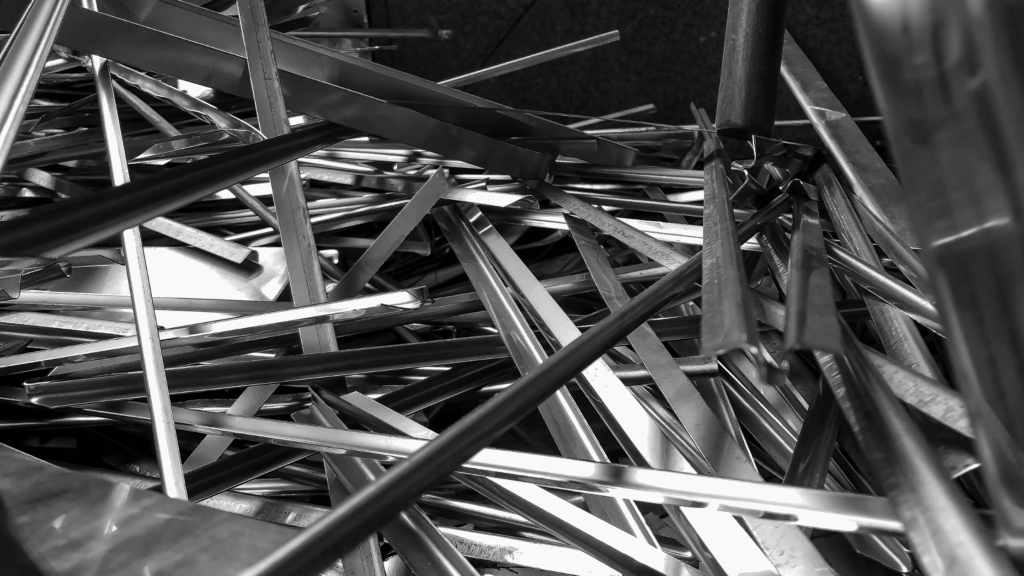Stainless steel recycling is crucial in promoting sustainability within the architecture, engineering, and construction (AEC) sectors. As a 100% recyclable material, stainless steel retains its properties through multiple recycling processes, making it an environmentally friendly choice. The recycling process involves collecting and processing scrap metal, which reduces the need for new raw materials and conserves energy. Incorporating recycled stainless steel into projects supports environmental goals and offers economic benefits due to fluctuating stainless steel recycling prices.
Quick look
- Stainless steel is 100% recyclable and can be reused indefinitely without losing quality.
- Recycling stainless steel conserves natural resources by reducing the need for mining raw materials like iron ore, nickel, and chromium.
- The stainless steel recycling process involves collecting, sorting, melting, and refining scrap metal to create new products.
- Recycling stainless steel cuts costs for manufacturers and stabilizes material prices in the construction industry.
- Using recycled stainless steel in AEC projects helps reduce emissions, lower energy consumption, and support sustainable building practices.
Is stainless steel recyclable?

Stainless steel is 100% recyclable. Its inherent properties allow it to be recycled multiple times without any loss in quality or performance. The recycling process begins with the collection of stainless steel scrap, which is then sorted and processed to remove impurities. The cleaned scrap is melted in a furnace, refined to achieve the desired composition, and cast into new products. This efficient process conserves natural resources and significantly reduces energy consumption compared to producing stainless steel from virgin materials.
The high recyclability of stainless steel is attributed to its composition, primarily consisting of iron, chromium, nickel, and molybdenum. These valuable elements can be recovered and reused indefinitely. In fact, according to the British Stainless Steel Association, any stainless steel object contains approximately 60% recycled content. This closed-loop recycling system minimizes waste and supports sustainable practices within the industry.
Where and how is stainless steel recycled?
Stainless steel recycling occurs at specialized facilities equipped to handle various types of scrap. The process begins with the collection of stainless steel from sources such as construction sites, manufacturing plants, and end-of-life products. Once collected, the scrap is transported to recycling centers, where it undergoes sorting based on alloy types and grades. Advanced technologies, including magnetic separation and spectroscopy, are employed to ensure accurate classification.
After sorting, the stainless steel scrap is cleaned to remove contaminants like dirt, oil, and non-metallic materials. The cleaned scrap is then melted in an electric arc furnace, where it is combined with other raw materials to achieve the desired alloy composition. The molten stainless steel is refined to remove impurities and cast into semi-finished forms such as slabs, billets, or ingots. These forms are further processed into finished products, ready for use in various applications across the AEC industry.
What is the average stainless steel recycling price?
The price of recycled stainless steel fluctuates based on market demand, alloy composition, and global economic conditions. As of recent data, stainless steel scrap prices can range from $0.45 to $3.00 per pound, depending on the specific grade and quality of the material. Industry professionals need to stay informed about current market trends to make cost-effective decisions regarding material procurement and recycling efforts.
What kind of stainless steel products can you recycle?
A wide array of stainless steel products used in both residential and commercial settings are recyclable. In the AEC industry, numerous components and fixtures made from stainless steel can be reclaimed and processed for reuse. Common recyclable stainless steel items include:
- Kitchen appliances (e.g., refrigerators, ovens, dishwashers)
- Sinks and faucets
- Cutlery and cookware
- Architectural panels and cladding
- Structural beams and supports
- Pipes and tubing
- Handrails and balustrades
- Fasteners (e.g., nuts, bolts, screws)
- Medical instruments
- Automotive parts
- Industrial equipment
- Storage tanks
- Electrical enclosures
- HVAC components
- Food processing equipment
Recycling these items allows valuable materials to be reintroduced into the production cycle, reducing the need for virgin resources and minimizing environmental impact.
Why stainless steel recycling is important

Recycling stainless steel is vital for both environmental sustainability and economic efficiency. The process conserves natural resources by reducing the demand for raw materials such as iron ore, chromium, and nickel. Additionally, recycling requires less energy than producing new stainless steel, leading to lower greenhouse gas emissions and a reduced carbon footprint.
From an economic standpoint, utilizing recycled stainless steel can result in cost savings for manufacturers and consumers. The fluctuating prices of raw materials make recycled content a more stable and affordable option. Moreover, the recycling industry generates employment opportunities and contributes to the circular economy, promoting sustainable growth.
Reduce fossil fuels
Recycling stainless steel significantly decreases the reliance on fossil fuels. The energy required to melt and refine recycled stainless steel is substantially lower than that needed for extracting and processing virgin raw materials. This reduction in energy consumption leads to decreased fossil fuel usage, conserving non-renewable resources. By prioritizing recycling, the AEC industry can contribute to energy conservation and promote cleaner energy sources.
Improve air quality
The recycling process of stainless steel contributes to improved air quality by minimizing emissions associated with primary production. Manufacturing stainless steel from raw materials involves energy-intensive processes that release pollutants into the atmosphere. In contrast, recycling reduces these emissions, leading to cleaner air and a healthier environment. This benefit is particularly significant in urban areas, where construction activities can impact air quality.
Reduces waste
Recycling stainless steel plays a crucial role in reducing on-site waste. By diverting scrap metal from landfills, the volume of waste generated by construction, demolition, and manufacturing is significantly reduced. This conserves landfill space and minimizes the risk of environmental contamination from metals leaching into the soil and water. Since stainless steel is highly durable and resistant to corrosion, properly recycled material can be repurposed for new applications, extending its useful life. The AEC industry, which generates substantial metal waste, benefits greatly from structured recycling programs that reduce disposal costs and promote sustainability.
Keeps our water clean
Extracting and refining raw metals consume large amounts of water, often releasing hazardous byproducts into rivers, lakes, and groundwater. Recycling significantly lowers this demand, preventing industrial runoff from contaminating drinking water supplies. Additionally, fewer mining operations mean less disruption to ecosystems, preserving natural waterways and reducing the impact on aquatic life. By supporting stainless steel recycling, builders and engineers contribute to a cleaner, safer water supply for communities.
Lowers carbon emissions
This recycling process helps cut down on carbon emissions linked to mining, transportation, and manufacturing. Extracting raw materials like nickel and chromium involves heavy machinery, blasting, and refining processes that release carbon dioxide into the atmosphere. Transporting these materials from mines to processing plants and then to manufacturers adds even more emissions. By recycling existing stainless steel, these steps are bypassed, significantly reducing carbon output. As the construction industry looks for ways to meet sustainability goals, using recycled stainless steel effectively reduces its environmental impact.
Supports sustainable construction
The AEC industry is increasingly shifting toward sustainable building practices, and stainless steel recycling plays a major role in this transition. Many green building certifications, such as LEED (Leadership in Energy and Environmental Design), reward projects that incorporate recycled materials. Using recycled stainless steel in construction helps reduce environmental harm and improves a project’s sustainability rating. Architects and engineers who prioritize recycled materials contribute to long-lasting, eco-friendly structures that align with industry standards for responsible building practices.
Reduces mining impact
Mining for stainless steel’s key components—iron ore, nickel, and chromium—can devastate landscapes and ecosystems. Large-scale mining operations cause deforestation, soil erosion, and habitat destruction, impacting both wildlife and local communities. Additionally, the extraction process produces waste materials that can lead to toxic runoff, harming nearby water sources. Recycling stainless steel reduces the need for new mining operations, lessening these environmental consequences and helping preserve natural resources for future generations.
Encourages responsible material use
By supporting stainless steel recycling, manufacturers and builders take an active role in responsible resource management. Rather than letting valuable materials go to waste, recycling ensures that stainless steel remains in circulation for new applications. This practice aligns with the principles of the circular economy, where materials are reused and repurposed instead of discarded. Stain steel’s long lifespan and durability make it an ideal candidate for continuous recycling, ensuring that fewer resources are wasted while maintaining the material’s strength and performance.
Bottom line
Stainless steel recycling is essential for the AEC industry, reducing environmental impact while offering economic benefits. Since stainless steel is 100% recyclable, incorporating recycled material into projects helps conserve resources, lower emissions, and cut costs. From structural components to everyday household items, there are countless opportunities to recycle and repurpose stainless steel. The industry can take a significant step toward sustainable building practices by prioritizing recycling efforts.
Want to stay informed about more sustainable practices in construction and engineering? Subscribe to Under the Hard Hat for expert insights and industry updates.


